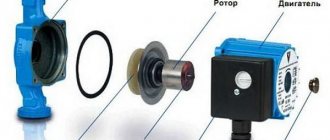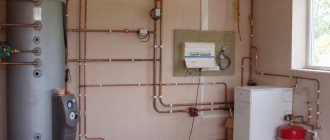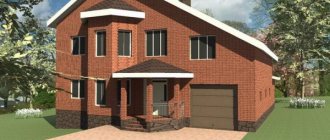What does autonomous heating mean in a private house and on which boiler should it be implemented? All this will be discussed in this article. So, what does autonomous heating mean? In most cases, this means that we are not dependent on an external energy connection. As a rule, this is a gas main. We all know that we have gas in our state, but we don’t have it.
How to get out of the situation and what type of fuel to heat the room. In an article about choosing a heating boiler for a house of 100 square meters. m. I briefly mentioned the ability of boilers using various types of fuel to operate in autonomous mode.
Let us introduce another concept about the autonomy of using a heating system. This is an important factor - the ability to turn it on, leave it unattended and without human participation in the process of maintaining a certain temperature.
Agree that it is possible to heat with wood, but it is inconvenient. You may even have to wake up at night to add firewood to the boiler. Last century.
Therefore, autonomous heating must be truly autonomous. At least for a few days, or better yet weeks.
Autonomous heating - what is it like in general?
Firstly, it can be heating that does not depend on the central power system of the house. Those. in the case when the boiler room is located in your apartment, and does not work for the entire block or a separate house (roof boiler room). For example, the autonomous heating of an apartment is its own wall-mounted boiler. In this case, gas must enter the apartment. This system has become very common among townhouse builders lately. Low-rise construction with apartment buildings. In this case, such residents also have autonomous heating from main gas. And it copes with its tasks very effectively, allowing its owners to maintain the comfortable temperature they require and at the same time be able to save on resources.
Secondly, by the expression autonomous heating in a private house we mean its truly autonomous operation. Those. without the participation of you and me. Here, of course, it’s worth clarifying a little how long exactly we want it (the system) to be autonomous for a long time. A day, three, a week. And we do not take into account the presence or absence of a network connection.
Thirdly, by autonomous heating, many mean a system that can run on fuel other than main gas. Because in most cases there is gas but it is not there. For several reasons. Perhaps the partnership where the house was built has prices for connecting natural gas such that it is easier to heat the house with electricity. Perhaps the site is located in such a place that it would take a whole large-scale operation to supply gas to it and it would not be worth it. In this case, it is necessary to design a system that is cheaper and more efficient.
Electric heating types
In terms of safety and environmental friendliness, electric types of heating are the most attractive. In addition, the cost of constructing electric heating will be significantly lower than liquid or air heating. After all, there is no need for any system at all. Heating devices themselves emit heat and can be installed in any room without any communications other than electrical wiring. Perhaps the main disadvantage that prevents the use of these devices to organize the main heating system is the high cost of electricity. To create electric heating, the following 4 types of equipment are mainly used:
- Infrared type heaters, which can be portable wall or ceiling mounted. The principle of their operation is based on the radiation of infrared waves, which are capable of heating objects around them. They, in turn, themselves become sources of thermal energy. Infrared heaters do not burn oxygen, as they do not have glowing elements. For this reason, they consume a minimal amount of electricity and are the most economical of all electric heaters available today.
- Electric convectors of various types. They can also be portable or fixed on the walls.
- Cable and film systems for heating floors or ceilings. This system is often used as an auxiliary one.
- Thermostats for heat regulation, as well as various programmable devices necessary to ensure the automatic operation of electric heating devices.
The main disadvantage of such a heating system, in addition to the cost of energy, is that it does not make it possible to provide hot water to the house. And its main advantage is the ease of construction and operation. Sometimes it is simply enough to place the device in the room and plug it into the household electrical network.
If you decide to build your own heating system in your private home, then you need to decide on its type. If your home is located in the southern regions, where winter temperatures do not drop below 10 degrees, then you can easily get by by installing infrared electric heaters in each room. They will provide efficient heating of the entire house, consuming a minimum of electricity. If you are a resident of the middle zone, and even more so of the northern latitudes or Siberia, then you cannot do without traditional liquid heating. There are several options for its device. Which one to choose is up to you to decide based on the current situation.
The second option for an autonomous heating system is the use of autonomous gasification.
The cost at the initial stage will of course be more expensive. In the future, the operation of such a heating system will be much more convenient. Once or twice a season we refill the container (gas tank) and everything works like clockwork.
Gas boilers are much more durable and easier to maintain. Plus, there is no need to store fuel somewhere.
Of all the systems (IMHO), this is perhaps the most convenient of the autonomous heating systems in addition to main gas and electricity.
When choosing an autonomous gas heating system, you need to look at a condensing boiler and use low-temperature heating in the house using heated floors. This will provide significant savings in gas consumption. Condensing boilers are capable of operating with increased efficiency compared to classic gas boilers. Condition one: the boiler must operate at a system temperature of 50/30 degrees. 50 degrees on feed and 30 gr. on the return line. This can only be achieved using a heated floor system.
Other options
Of course, now there is also heating with solid fuel (coal, wood), but it is difficult to use in apartments! You won't be storing bundles of firewood for the winter, will you? Yes, and it is a fire hazard.
Alternative sources are another matter, now there are geothermal, solar, wind, etc. heating. Of course, the efficiency is not always 100%, but if you combine all three at once, it can turn out very well - I would say almost for nothing.
Probably, now many people thought - damn, how cool, I also want to heat my apartment autonomously, I’ll cut off these “central” radiators - I don’t need them! Yes guys, I thought so too, but our government doesn’t think so, you can’t just cut off the radiators in the apartment! Let's read this article. Therefore, those who have central heating may not even dream of installing autonomous heating.
That's all, I think now you understand what it is and why it is needed at all. If you are buying a new apartment, pay attention to this!
Read our construction blog.
Classification
The main element in autonomous heating systems are heating boilers. They are distinguished by the type of fuel used:
- gas;
- electrical;
- solid fuel;
- liquid fuel.
Regardless of the type of boiler, all autonomous systems operate on the same principle:
- Fuel is loaded into the boiler.
- The boiler then burns it, thereby heating the water.
- Heated water is passed through pipes.
- Pipes with hot coolant heat the room.
The total cost of a heating boiler takes into account not only the price of the fuel itself, but also the efficiency of its supply equipment. The higher it is, the more heat you can get.
In terms of year-round performance, devices with less processing power are preferable. It is advisable to choose a boiler with automatic control, which adapts the characteristics to the prevailing conditions and allows you to save money. For the correct and economical functioning of the heating system, you also need to fine-tune its operation.
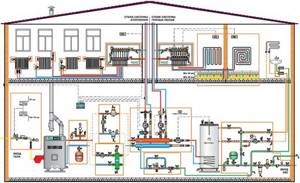
To reduce costs, it is recommended to choose a high-capacity boiler, such as a wood gasification boiler or a modern and fully automated biomass unit.
Remember that a fireplace or stove can be an excellent additional source of heat in the home that will reduce heating costs. It makes sense to choose a device with storage capabilities. Heat can also be distributed throughout the home using an air heater system or a power source in a water jacketed fireplace.
Installation recommendations
Any homeowner may have a natural question regarding electric heating. Why install a boiler and fence pipes with radiators when you can lay cable heated floors or install heating around the perimeter of the rooms using baseboard convectors? The argument in favor of the water system is one, but important: it can be connected to any heat source. For example, tomorrow the electricity tariff will rise, and you have a heating circuit made of cable mats, it is impossible to switch to another energy source.

Another tip is that when organizing a new heating system, it is better to replace the radiators as well. But before you start installing autonomous heating, you need to properly disconnect them from the risers. To do this, the battery is dismantled along with the bypass, and a piece of pipe of the same diameter as the riser is inserted into the resulting gap.
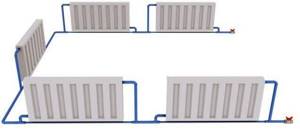
The operation is performed with a steel pipe using welding or a metal-plastic pipe with threads and press fittings. Since wall-mounted boilers always have a built-in circulation pump, a single-pipe system with no more than 5 radiators is suitable for heating a small one-room apartment with an area of 35-40 m2.

If the living area is larger, then for your own convenience it is recommended to make a two-pipe system with lower wiring. As an example, a diagram of an autonomous heating system combined with hot water supply is shown below:
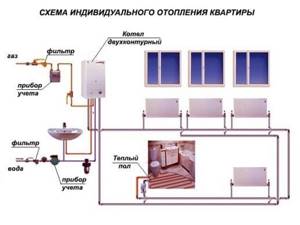
Air heating at home
In our country it is not very popular, although it has good effectiveness. Heated air is supplied to the premises through special ventilation ducts, which can be located in the floor or ceiling. Air heating of a house consists of the following elements:
- Heat generator. For these purposes, a heating boiler operating using any energy carrier can be used.
- Air ducts. They deliver warm air from the heat generator to the premises.
- Supply fan. Performs the movement of air masses.
Part of the air for the operation of the equipment can be taken from the street, and part from the premises. It is better to entrust the installation of this type of heating system to professionals, because independent installation is quite labor-intensive.
Advantages:
- High efficiency – up to 90%.
- No need to spend money on radiators.
- Can be used in conjunction with air conditioning.
- Good adjustability due to low inertia of air masses.
Flaws:
- Installed during construction of buildings.
- Requires periodic monitoring and maintenance.
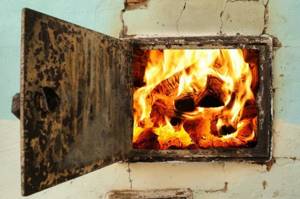
Bake
Stove heating
Refers to air heating, because heating occurs due to heated air masses that circulate through channels located in the walls. The good thing is that it allows you to do the heating of a private house with your own hands, provided that the property owner is at least a little familiar with bricklaying.
The stove is usually made with wood or coal and is usually installed in the middle of the house, since in this case the heat will also be transferred by radiation. It will be an ideal choice for small buildings, such as summer houses.
Advantages:
- Availability.
- Possibility to use solid fuel - no need to contact natural gas supply companies.
- Easy to use.
- Durability.
Flaws:
- Periodic cleaning of smoke channels is necessary, as they become clogged.
- Difficult to adjust.
- Requires the presence of a person to periodically add fuel.
- Stove heating can heat a small building, as heated air masses circulate slowly.
- Uneconomical.
Electric heating
This type works on electric boilers. Its advantages:
- low noise level during operation;
- affordable price;
- reliability of design;
- easy installation.
The service life of electric boilers is 15 years . Heating a house with this system makes it possible to program the air temperature. This can be done using a temperature sensor, which is best installed in the coldest room.
- high cost of electricity;
- the need for constant access to it.
Loft
This year the style remains in demand. It is often used to equip kitchens combined with a living room. This combination gives more free space, which will only emphasize all the details of the loft.
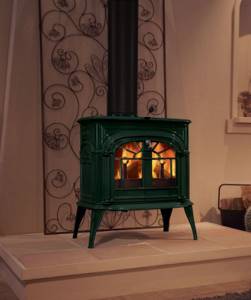
For example, stylists play with brickwork, wires or concrete walls. The photographs clearly show how successful it can look like a living room that is combined with a kitchen.
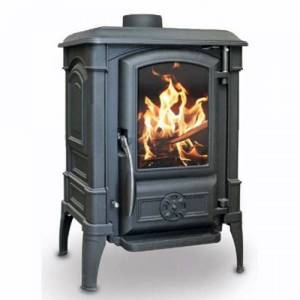
For loft, rough and heterogeneous surfaces and rough materials are selected. In apartments decorated in this style, wall lamps are installed. In this case, the light is directed along the walls.
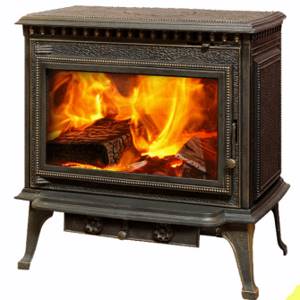
Due to this, shadows fall so that uneven surfaces look three-dimensional. At first, loft was viewed with caution, but it quickly became popular. Designers do not hide finishing materials and even fake them. To imitate a concrete surface and smudges, decorative plaster is used.
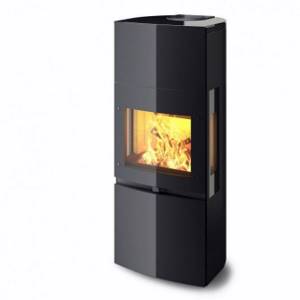
Pipeline layout
While heating engineers are discussing the optimal heating scheme for a central heating house, the issue of proper piping in the house is raised. In modern multi-storey buildings, the heating layout can be implemented according to one of two possible patterns.
Single pipe connection
The first template provides for a single-pipe connection with upper or lower wiring and is the most used option when equipping heating appliances in multi-storey buildings. At the same time, the location of the return and supply is not strictly regulated and can vary depending on external conditions - the region in which the house is built, its layout, number of floors and design. The direct direction of movement of the coolant along the risers can also change. There is an option for the heated water to move in the direction from bottom to top or from top to bottom.
The single-pipe connection is characterized by simple installation, affordable cost, reliability and long service life, but it also has a number of disadvantages. Among them are the loss of coolant temperature while moving along the circuit and low efficiency indicators.
In practice, various devices can be used to compensate for the shortcomings that characterize a single-pipe heating scheme; a radial system can be an effective solution to the problem. It is designed to use a collector that helps regulate temperature conditions.
Two-pipe connection
A two-pipe connection is the second version of the template. A two-pipe heating scheme for a five-story building (as an example) is devoid of the disadvantages described above and has a completely different design than a single-pipe one. When implementing this scheme, the heated water from the radiator does not move to the next heating device in the circuit, but immediately enters the check valve and is sent to the boiler room for heating. Thus, it is possible to avoid loss of temperature of the coolant circulating along the contour of a multi-story building.
The complexity of the connection, which is implied by the two-pipe scheme for connecting a heating battery in an apartment, makes the implementation of this type of heating a long and labor-intensive process, requiring large material and physical costs. Maintenance of the system is also not cheap, but the high cost is offset by high-quality and uniform heating of the house on all floors.
Among the advantages that the two-pipe heating radiator connection scheme provides, it is worth highlighting the possibility of installing a special device - a heat meter - on each radiator in the circuit. It allows you to control the temperature of the coolant in the battery, and by using it in the apartment, the owner will achieve significant results in terms of saving money on utility bills, because he will be able to independently regulate the heating if necessary.
Video – cost of installing a turnkey geothermal system
high cost
purchasing the necessary equipment;
payback
installation is possible only after 7-8 years;
the need to build a collector
.
This might be interesting!
In the article at the following link, read about heating radiators for a private home.
Heating with solar panels
An alternative and environmentally friendly way to obtain heat is to install heating using solar collectors. In regions with low solar activity, this method is used as a backup or additional option.
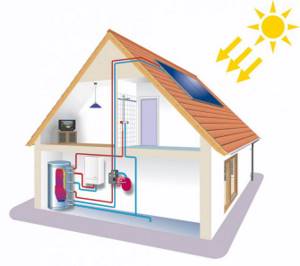
For the greatest efficiency of the system, it is necessary to correctly position the batteries on the roof
big
service life;
availability
installation equipment;
the best option for obtaining heat from electric heaters
and when installing heated floors;
simplicity
in operation;
no costs
for the purchase of fuel.
Energy from renewable sources
The most efficient heating equipment is considered to be one that uses renewable energy. In cold climates, these are primarily heat pumps, which convert free energy from earth, water or air into heat. This, in turn, powers the domestic heating system and heats the water.
A heat pump is one of the most modern heating devices that does not require maintenance, is inexpensive, and environmentally friendly. It is well suited for those who care about comfort.
Autonomous heat supply - what is it?
When centralized heating is used, there is no way to regulate its intensity depending on weather conditions, and utilities must be paid in full.
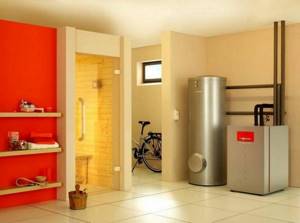
If autonomous heating is used, then external energy sources are not used. In this situation, residents do not depend on the operation of an external heat source.
Where can it be used
This heating method can be used in multi-apartment and private buildings. It can also be used in offices or production areas for workers or machine tools.
The basis of everything is a plan
Without knowing it, we completed the first point of the work plan - we calculated the required thermal power for heating. The general plan also includes determining the location and number of radiators, selecting pipes and necessary accessories (fittings, taps, manifold distributors, filters and other necessary parts of the heating system). The plan, usually drawn in enlarged form, marks the location of all the elements that a homemade heating system provides, and in addition, it allows you to select heating devices.

Detailed heating plan
As a rule, any radiators will work in a heating system; the only question is how much they cost and what they look like. They are usually located under window openings to provide a thermal curtain. When choosing radiators, you can be guided by a rough estimate - if the coolant temperature is seventy degrees, then one section is used to heat an area of three square meters. m.
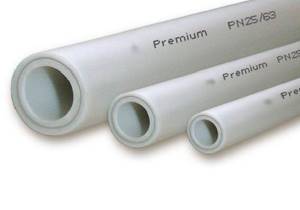
Metal-plastic pipes






